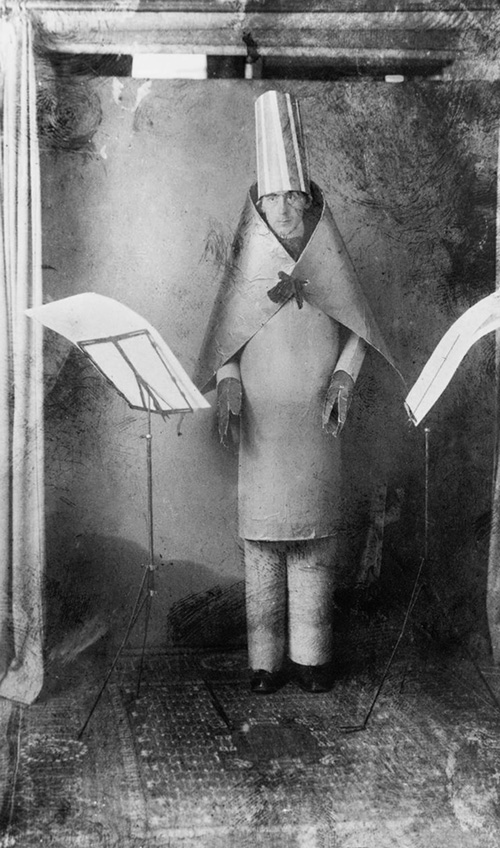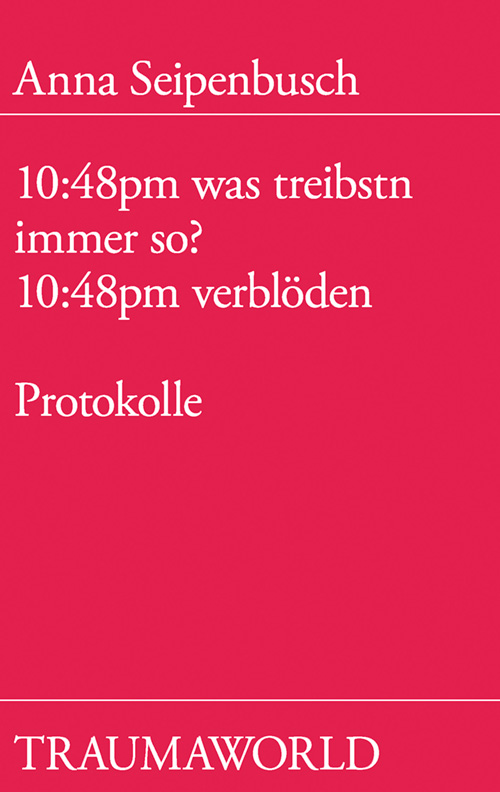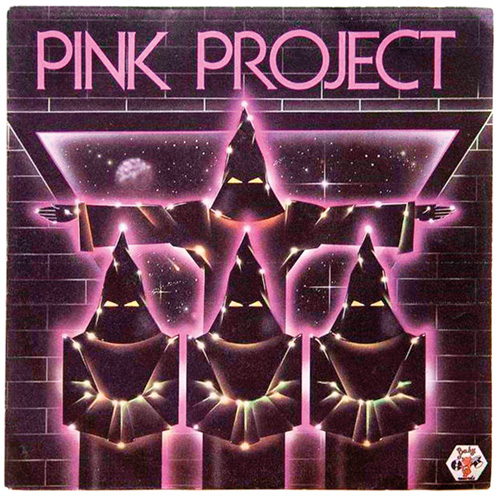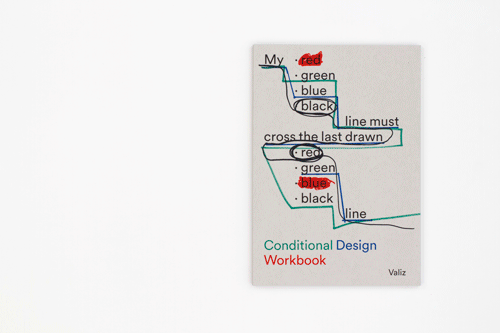July 1916: One year after creating the Cabaret Voltaire with his partner Emmy Hennings, Hugo Ball delivers the first public reading of his Dada Manifesto. He begins with an excursus on the “international” nature of the term, and ends by describing the power of words to define the world around us: “The word, gentlemen, is a public concern of the first importance.” Through their consummate art of provocation, the adherents of Dadaism intended to subvert the norms of their epoch by liberating words and languages from their arbitrary assignations.
He begins with an excursus on the “international” nature of the term, and ends by describing the power of words to define the world around us: “The word, gentlemen, is a public concern of the first importance.” Through their consummate art of provocation, the adherents of Dadaism intended to subvert the norms of their epoch by liberating words and languages from their arbitrary assignations.
Sparta My Have
June 2012: The security team at the electronic commerce company Amazon.com discovers a type of unauthorized publication. It is neither a manipulation of user comments, nor is it promotional spam. The “problem” concerns a massive influx of books of an unfamiliar nature, absurd works written by digital programs. For four years, the software is flooded with such evocatively titled books as Sparta My Have by Loafrz Ipalizi, Weird Song You Cute by Timsest Pitigam, or Alot Was Been Hard by Janetlw Bauie. Each opusconsists of short texts signed by a pseudonym.
The statements read like transcripts from delirious conversations between adolescents sitting in front of a TV, rather than novels situated within a prizewinning literary canon. As it turns out, they have been compiled from accumulated YouTubecomments. Extracted by a software program, they are then reassembled into book form before being published —and sold—on Amazon. Some weeks later, the books were removed from the site, and the guilty parties were revealed to be the Austrian art collective Traumawien and the German Bernhard Bauch.11 Traumawien, “Ghost Writers” (2012): http://b-o.fr/ghostwriters The authors of this intricate performance—called Ghost Writers—describe the result as a collection of e-books portraying the contemporary micro-dramas at play on community websites. For them, what is at issue is a new form of emergent literature produced by the users of the online video host.
—and sold—on Amazon. Some weeks later, the books were removed from the site, and the guilty parties were revealed to be the Austrian art collective Traumawien and the German Bernhard Bauch.11 Traumawien, “Ghost Writers” (2012): http://b-o.fr/ghostwriters The authors of this intricate performance—called Ghost Writers—describe the result as a collection of e-books portraying the contemporary micro-dramas at play on community websites. For them, what is at issue is a new form of emergent literature produced by the users of the online video host.
This kind of artistic expression is evidence of the dissemination of bot use. Bot is a diminutive of “robot” and refers to an automatic or semi-automatic program capable of interacting with servers. Halfway between literary experimentation and robot, these quasi-random productions of the Traumawien Collective share characteristics of both the Dada artistic movement and computer bots.
July 2014: The Associated Pressannounces that its quarterly earnings articles will henceforth be handled automatically by a software written by the firm Automated Insights.By analyzing the economic data sets of Zacks Investment Research, the program instantly produces dispatches of between 150 and 300 words that are then circulated on nearly 150 Anglophone economic press websites. In an interview on the subject, Lou Ferrara (editor-in-chief Automated Insights) explained that by allowing journalists to spend less time crunching financial numbers, the software frees them up to produce more penetrating coverage of social issues. The same strategy was used by Narrative Science, a start-up that automatically compiles the outcomes of football and baseball games based on statistical data.22 Justin Bachman, “Are Sportswriters Really Necessary?,” Business Week (2010): http://b-o.fr/bachman
Seen in the light of this automatic writing of the present, the “ghost writers” of Traumawien figure within an evolution of editorial practices that goes beyond mere schoolboy pranks. The principal literary trait of these books lies in the algorithmic procedures that determine their agencement. What do these automated combinations of heterogeneous content disclose? What is the aesthetic status of such productions? Who is the author? These different examples demonstrate that a single logic is at work in the creation of this editorial material, in the online works as well as their print counterparts. Their production is “algorithmic,” i.e. software instructions automate the research, assembly, and creation of content.
Algorithmic Culture
Such examples testify to the increasing impact of software functions in the diffusion and production of new cultural content. In other words, we are witnessing the appearance of an “algorithmic culture,” one reflecting the increasing influence of digital and computer programming in the production and diffusion of cultural products. By “culture,” we understand the ensemble of practices affecting domains as diverse as music, literature, cinema, sculpture, journalism, photography, gastronomy, fashion, etc. The term “algorithmic,” used here as an adjective, points to the motor of computing, that is, to the use of coded processes in programs that make possible the organization, compression, assembly, sifting, comparing, and classifying of information, on the basis of preexisting coordinates. The software used in our day-to-day management of information is composed of a multitude of algorithms permitting the execution of tasks for which they have been designed. This can mean, on the one hand, furnishing users with productive tools, for example the possibility of creating a virtual world in 3D with a program called Unity (2005). On the other hand, enabling users to access and modify preexisting content in a more or less exhaustive manner.
The exploration of this “algorithmic culture” reveals the determining influence of computation on cultural content itself. In certain cases, this can give rise to its own specific aesthetic, as in the case of chiptunemusic33 Nicolas Nova, 8-bit Reggae: Collision and Creolization, (Paris: Éditions Volumique, 2014). or the glitch current.44 Rosa Menkman, The Glitch Moment(um), (Amsterdam: Institute of Network Cultures, 2011). In other cases, it can give rise to “augmented” practices or experiences of reality. Video games present a type of content intrinsically related to algorithms implemented within digital technologies that enable the creation of virtual universes in which users can carry out actions whose effects are visually registered on a screen. Lastly, the notion of algorithmic culture can just as easily produce an effect of hierarchization in the selection and suggestion of one set of content rather than another.
In this respect we may distinguish between algorithms whose purpose is to aid in the selection/distribution of cultural goods and algorithms of production. It is their productive function that interests us here. In an era in which computer programs take charge of more and more of what previously figured as properly human activities, the increasing automation of creative processes constitutes a pertinent point of reference from which to grasp the automation of algorithmic processes in our society. It is not a question here of restoring the primacy of the author in the creative process. It is a matter rather of putting into perspective the specter of productions and human-machine collaborations engendered by these sorts of hybridizations. The esthetics and the coherence that spring from these productions can never be fully foreseen, for they are always the fruit of a generative process that is never completely random.
The Language of New Media
In his essay The Language of New Media (2001), Lev Manovich introduces the notion of new media objects to describe the content produced by digital technologies.55 “A new media object may be a still digital image, a digitally composited film, a virtual 3D environment, a computer game, a self-contained hypermedia DVD, a hypermedia Web site, or the Web as a whole.” Lev Manovich, The Language of New Media (Cambridge, MA: MIT Press, 2001), 14. What interests him are the principles governing their functioning. The first such principle concerns the presence of a digital representation. A photograph taken on Instagram (2010), a piece of music on Soundcloud (2008), a GIF found on Tumblr (2007), a Tweet, etc.—all of these cultural elements are encoded in a numeric format. A second important characteristic lies in the modularity of digital objects, the way in which they tend to be imbricated in one another. Whether it be a piece of music, a YouTube (2005) video, a PDF text, etc., every “media object” consists of an assemblage of blocks that can take various forms. These different blocks can be combined amongst themselves and this is the exact logic at work in the books produced by the Ghost Writers bots.66 Traumawien, op. cit. They function as aleatory media objects, of textual commentaries and visuals extracted from YouTube, the outcome of which can then be considered independently. The selection criteria and organization of this heterogeneous content is accessible and “readable” only by means of the potentialities defined within the program in question.
More and more designers and artists are taking advantage of this hybrid rhetoric, developing increasingly advanced projects. Consider James Bridle’s A Ship Adrift (2012).77 http://shipadrift.com Using a website updated on a daily basis, Bridle reconstructs the journey of a navigator adrift. The virtual movement of the boat follows the speed and force of winds detected by sensors situated in the statue of a boat placed on the roof of the Southbank Centre in London. In parallel, a program tracking geolocated content such as Tweets, Wikipedia entries, or ads posted online on bulletin boards are linked to places and events situated in the vicinity of the supposed position of the boat. Each day, data is selected and posted to the site. This project reveals another characteristic of digital objects: photos, videos, sound extracts and texts are accompanied by metadata. Photographs carry with them the date, time, camera model and settings, as well as the geolocation at which they were taken. James Bridle’s project functions specifically through the usage of geographical metadata which serves as a point of reference in relation to which diverse and daily cultural elements can be reassembled.
Various sociological theories allow us to account for such phenomena. Owing to its decentering of Western themes, Basil Zimmermann’s work on the role of technical objects in the creation of electronic music in China opens particularly fruitful paths for such purposes.88 Basile Zimmermann, Waves and Forms: Electronic Music Devices and Computer Encodings in China, (Cambridge, MA: MIT Press, 2015). In his research on memes, Zimmermann outlines an atomic approach to “culture.” 99 A meme refers to an idea, behavior, or style that spreads from person to person within a culture. Applied to digital culture, a meme constitutes a unity, typically an image, passed between individuals in a viral manner. Observing how “Western” content can circulate inside China by means of electronic music samples, he proposes the notion of a “cultural element.” The latter refers to the way in which every content or cultural object—including Manovich’s new media objects—can be composed of subordinate unities.1010 Basile Zimmermann, “Redesigning Culture: Chinese Characters in Alphabet-Encoded Networks”, Design and Culture, 2:1, (Abingdon: Taylor & Francis, 2010), 27–43. For example, we could say that the Ghost Writers of Traumawien or James Bridle’s A Ship Adrift combine diverse cultural elements in order to produce a new artistic work. As we have seen, by encoding content of distinct natures in a common fashion, new media objects are intrinsically hybrid.
Remix and Mashup
The principle of hybridization or remixing comes out of a long tradition in musical, audiovisual, and literary fields. The tendency underwent a popular explosion in the 2000’s due to the newfound uses of digital mixing software as well as the unprecedented availability of material provided by the internet, and in particular of specialized blogs. Old and new samples, serious and kitsch versions, hard rock, disco, folk, hip-hop, house, or pop music offer infinite repositories of genres on the basis of which new esthetic directions can be redefined. This tendency of “remixing” can be traced back to Jamaican sound systems and, at the turn of the century, has been particularly significant with the production of bootlegs, also known as mashups. A mashup consists of two or more samples which are combined to form a new sample. Regardless of period or genre—the old and the new, the kitsch and the serious, the riffs and the kicks, folk, hip-hop, house, etc.—everything can potentially be combined to generate a new esthetic direction.
A mashup consists of two or more samples which are combined to form a new sample. Regardless of period or genre—the old and the new, the kitsch and the serious, the riffs and the kicks, folk, hip-hop, house, etc.—everything can potentially be combined to generate a new esthetic direction.
The term mashup has progressively migrated from the field of music to that of web design, notably with the Web 2.0 culture that emerged in the mid 2000’s. In this context, it refers to applications remixing heterogeneous content: the superimposition of two images or the combination of sonic and visual objects in an internet meme, or a site aggregating content originating from other sources, etc. Collecting, extracting, combining, archiving, etc., the new digital software has transformed the art of sampling into a veritable form of engineering. The algorithms that make up this software have increased the possibilities of rearrangements tenfold, with the new media objects presenting a repository of primary material readily available online.
At the heart of this logic of hybridization lies the persistence of past cultural elements. Derrida describes this phenomenon as “hauntology,” the accumulation and resurgence within the creative process of phantasmic traces from the past.1111 Jacques Derrida, Spectres de Marx (Paris: Galilée, 1993). In terms of resonance, the concept hearkens back to “ontology” (the metaphysical study of existence) by operating a hybridization of the verb “to haunt” (a phantasmic presence) and the noun “anthology” (which describes a compilation of excerpts). Composed with various elements from the past, a hauntologic piece acts as a vehicle for ghosts from the past. This “virtual presence” characterizes those “‘absent’ actors with whom users collaborate through the mediation of technology.” 1212 Basile Zimmermann, De l’impact de la technologie occidentale sur la culture chinoise : les pratiques des musiciens électroniques à Pékin comme terrain d’observation de la relation entre objets techniques et création artistique (PhD diss., University of Geneva, 2006).
People’s decisions, choices, mistakes—whatever we choose to call them—are stored within the technology. In turn, users, among them artists, are collaborating with the virtual presence of the (often many) people whose actions have been embodied, temporarily or permanently, inside the tools.1313 Ibid.
For example, a recognizable guitar sample captured in a digital content can give the impression that the musician in fact participated in its creation. The cultural element of a guitar sample circulates thus from piece to piece through the mediation of machines. Internet memes and musical mashups constitute interesting examples of processes of hybridization at work in contemporary creation. However, things are advancing further still, since it often happens that these recombinatorial operations take place as an effect of the digital programs themselves, without even being consciously intended by their authors.
The Advent of the Bots
Regarding the aforementioned digital objects, these programs can be used by anyone to modify photographs, or add a soundtrack to a video with digital programs. These are fairly straightforward cases of hybridization. However, it is increasingly common for these processes to be automated. For example, we use software whose algorithms gather and optimize the contrasts and contours of faces in photographs that we take on our smartphones. Once launched by their users, such software automatically calculates the optimal levels according to preset parameters put in place by their programmers.
In the field of culture, “software automation” is used more and more to carry out repetitive tasks, which can thus be accelerated. Sometimes, they operate in a highly discreet manner, as in the case of Wikipedia, where they carry out an increasingly variegated set of typographical, syntactical and semantic modifications. Hence the updates and links between articles that continually augmentthe collaborative encyclopedia.1414 R. Stuart Geiger, David Ribes, “The Work of Sustaining Order in Wikipedia: The Banning of a Vandal,” Proceedings of the 2010 ACM Conference on Computer-Supported Cooperative Work, (New York: ACM, 2010). 117–126. Even if these sorts of interventions into contents may appear elementary, the progress made in the automatic generation of text is palpable.
Twitterbots, the conversational agents used on the social networking site, offer yet another even more current example.1515 Interactive agents simulate human reactions in instant messages, social networks, or automatic answering machines, and are in general rather frustrating. Numerous accounts on the social network generate absurd, comedic, or poetic messages. The term “Weird Twitter” is generally used to refer to the vast ensemble of accounts that toy with typographical and syntactical microblogging codes.
This logic of bot programming extends to many other ventures beyond just Twitter. The Death of the Authors (2013) by the artistic collective Constant is a combinatory literature project that automatically generates novels based on the texts of James Joyce, Henri Bergson, and Virginia Wolff.1616 Constant, The Death of the Authors, 2013: http://b-o.fr/constant With a single click on their website one can generate phrase combinations drawn from these classic works.
Generative Culture
Scheming, cryptic or mischievous, these projects may not always be coherent, however they are emblematic of a digital culture constructed from the fragments of pre-existing cultural elements. Regardless of their beauty or harmony, such explorations serve above all to highlight the place of processes and tools of chance in the production and distribution phases. Such experimentation figures routinely in generative art, i.e. content produced automatically by digital programs “[which] refers to any art practice where the artist uses a system, such as a set of natural language rules, a computer program, a machine, or other procedural invention, which is set into motion with some degree of autonomy contributing to or resulting in a completed work of art.” It should also be pointed out that this creative logic has long been present in the history of art, in particular amongst the conceptual artists of the 1960s (Sol Lewitt, Joseph Kosuth, Lawrence Wiener, Douglas Huebler, among others) or, more recently in the field of graphic design, with the Conditional Design manifesto (2013) published by Studio Moniker.1717 Luna Maurer, Edo Paulus, Jonathan Puckey, Roel Wouters, “Conditional Design. A Manifesto for Artists and Designers,” 2011: http://b-o.fr/conditionnal 
A wide array of such works have appeared over the past forty years supported by multiple digital languages that have been specially developed to facilitate such generative creations: Design by Numbers (DBN, 1999–2003), by graphic designer John Maeda, Processing (2001) by Ben Fry and Casey Reas, or SuperCollider (James McCartney, 1996), a programming environment and language used for improvised interactive programming during performances. The main difference today lies in the profusion of data accessible through digital networks. The latter forms a potentially infinite matrix from which it is possible to generate new content randomly and indefinitely.
Variability and Remediation
Another characteristic of these algorithmic cultures, and in particular those of new media, derives from the fact that every cultural object can potentially undergo an array of modifications.1818 “Variability.” See Lev Manovich, op. cit., 36. Depending on the cultural field in question, the author, the designer, the composer, the graphic designer, the architect or even the user can modify cultural elements. Changing the words to a song or the colors of a painting, speeding up a musical sample, adjusting filters on Instagram, etc. is possible thanks to the precision of the algorithms handling the processing, presentation, and manipulation of complex data. Even where these operations are activated by a human user, this presence is obsolete, since each operation can be performed independently of the user’s request. Automatic focus on digital cameras, suppression of “red eye” or the centering of a face detected in the captured scene are familiar examples of this implicit automation.
In addition to those changes voluntarily implemented by the user, machines and software employed by users can also influence the content itself.1919 This is what Lev Manovich has called “cultural transcoding.” Ibid. 46–47. Technical objects convey cultural elements or ethnocentric components that directly affect the creative process, as seen in Zimmermann’s work. Put otherwise, technical objects—hardware and software—can transport cultural elements and logics that steer the creative process.
Towards a Machinic Creolization?
Beyond the simplistic logic of the remix and the mashup, the originality of algorithmic cultures resides in the potentialities emerging from the processes of automation taking place between ever more active bots. Additionally, the cultural elements widely available online form a massive and novel material resource for such programs. In a parallel fashion, the logic of modification brought about by algorithms and the machines that execute them shows that the cultural forms they produce are more than a mere reorganization of existing cultural elements. Their constituent elements are transformed in and through these mixtures, producing new and singular contributions. Put otherwise, it is like listening to a remix whose samples were transformed organically in the course of the playback under the influence of the algorithms of the program.
Such a dynamic evokes a cultural phenomenon well-known to linguists, anthropologists and poets, mainly that of creolization. As Edouard Glissant describes it, the term refers to the “meeting of multiple cultures, or at least of multiple elements from distinct cultures, in a single place in the world, resulting in the emergence of something new and totally unforeseeable when considered only as the sum or synthesis of its elements.” 2020 Édouard Glissant, Traité du Tout Monde (Paris: Gallimard, 1997), 37. Without delving into the complex history of the word creolization, we may simply recall that the notion derives from the use of the word “Creole” which, during the 16th century, served to designate those individuals born from the collision and mixture of populations in the American and Caribbean New World. Over the course of time, the word “creolization” came to refer to the process of intercultural exchange giving rise to a new language, one influenced by the original mother tongues of the people in question.2121 Peter Mühlhäusler, Pidgin and Creole Linguistics (Oxford: Basil Blackwell, 1986). Such is the case with Haitian Creole and Jamaican Patois. The term creolization has since been used by historians and anthropologists to describe and understand the intercultural exchanges that go beyond simple linguistic matters, as in the intermixing of alimentary or musical traditions arising through a logic of mutual entanglement and the transformation of constituent elements.
We are aware that such a transposition of the term is not uncontroversial. Are we really dealing with the same process? Any application outside of its original postcolonial context is potentially problematic and it remains an open question. Whether it be the omnipresence of samples and mashups, the influence of presets and autotune, the circulation of glitches and memes, the strange humor of Twitterbots, etc., the algorithmic mechanisms at work in all of these projects outstrip the common idea of hybridization. We thus propose the hypothesis of a “machinic creolization,” that is, the constant automation of hybridized and altered cultural elements. With this term, we wish to underline the fact that “creolizing” processes of creation can be carried out by machines and algorithms entirely on their own. This is a globally novel situation.
This paper is an edited version of a text initially published in Databots, a collective book edited by Nicolas Nova and Joël Vacheron of IDPure Magazine (Morges, 2015).